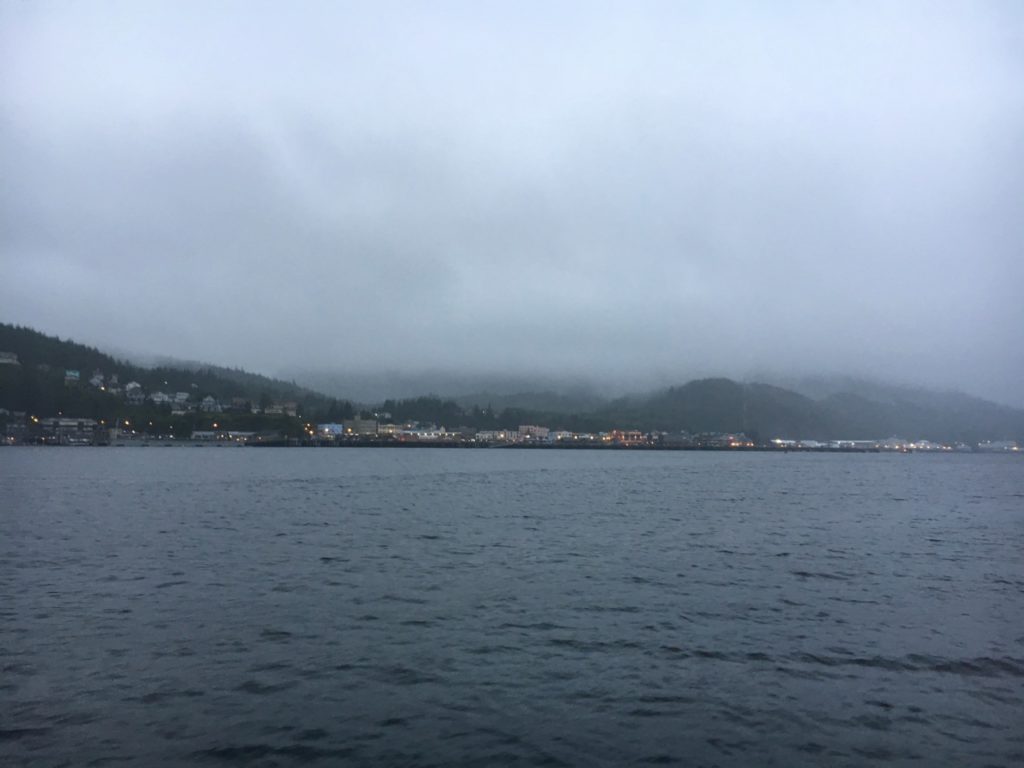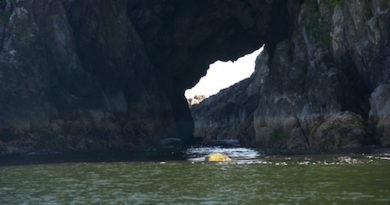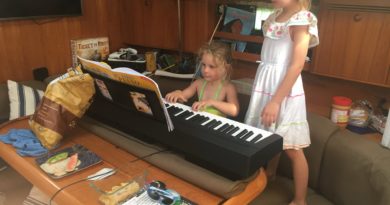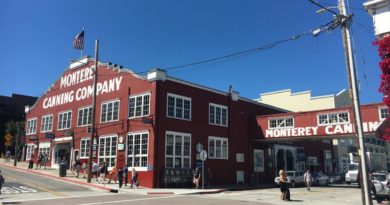Racing the Storm
(Aug 16th, 2017)
Take two. For the second day in a row, I awoke at 5AM. More confident of our departure window today, I set to work listening to weather and making coffee, while Rich did a final garbage run and unhooked the power.
Normally, today’s forecast would have been less than ideal: a gale warning, with a 15-20 knot southerly in the morning, then a 5-15 knot southwesterly for the rest of the day, and finally a building gale overnight. Rain. A high of 56 degrees.
But, weather forecasts are relative, and compared to the prior day’s gale in the relatively protected waters of Ketchikan, and the even bigger gale coming in the next day, we knew this was the best window we’d get for some time. The northerly following this series of lows was simply not going to arrive – probably until next summer – and so this was our weather window. Unlike the decision to stay the day before, the decision to leave was an easy one to make. With one final check to make sure we had plenty of fuel, the go-or-no-go was called: it’s a go.
We left Bar Harbor before 6AM. The waters in Tongass Narrows were calm. In the dim light, with thick rain, we were thankful for the ships using their anchor and navigation lights, and extremely grumpy at those who weren’t. Radar was a must for the morning.
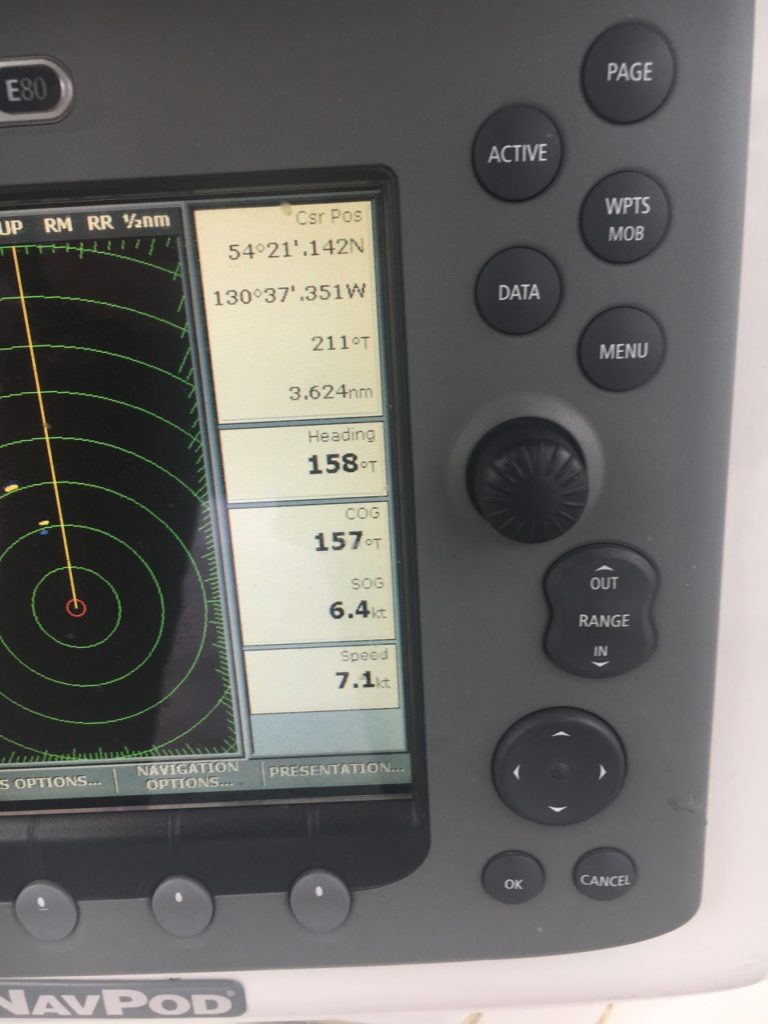
Rich took the first shift. We started with one-hour shifts, just to see how the day was going to go, and how long we’d manage to maintain adequate watch in cold wind, ocean spray, and driving rain. (Yes, we have a fully enclosed cockpit, but lulled into complacency by the prior two weeks of sun, we had removed the enclosures and stowed them just a few days prior.) He spent some time on the radio communicating with the bridges of the three cruise ships coming in for the day, ensuring they would make their way north past us without incident. We kept to the side of the channel to ensure they’d have adequate space to pass, and we watched as their behemoth structures glided past.
At 7AM, after making and serving breakfast, I took my shift. We were just leaving Tongass Narrows, and entering the less protected waters leading to Dixon Entrance to the south. The wind picked up to 10-20 knots, making for rough seas. Although we were nose-to-the-wind, I put up the sail in the hope that it would stabilize our motion in the chop, and maybe even help us gain a tenth of a knot or two. Looking back, the sail may have slowed us down.
With the wind on our nose, our water speed was significantly retarded. We were hindered further by the fact that we were essentially motoring uphill – wind-driven waves pushed back against us as we plowed through and over them. We only averaged about 6 knots through the water, and less over ground. Our long crossing was getting longer by the minute.
At 8AM, Rich geared up and came up for his shift. We decided to make the next round a two-hour shift. I thought this was a great plan, because by the end of my second shift, our 12-hour run would be halfway over. When I saw our boat speed, I should have realized that my optimism was unfounded.
By the time I made my way downstairs, the girls were awake and playing. I helped them get the breakfast I’d made nearly two hours before, and get ready for the day. By the time they were happily playing on their own again, my tummy was starting to feel a bit queasy in the tumbling seas. I gave each of the girls a Dramamine to ensure they didn’t suffer the same fate, told them they could watch a movie, and tried to get an hour of sleep before my shift began. Laying down, I felt fine, although I wasn’t able to sleep because the bow where I laid kept slamming down in the waves. After some time my alarm went off, and I got up to don my gear and take my second shift.
Whoa. Standing up was not fun. The instant I left a horizontal position, my body revolted, sending waves of nausea over me. I changed into my fleece sweater, put on my rain pants, hat, vest, coat, and shoes as quickly as I could, and headed out to the cockpit.
“You okay?” Rich asked immediately when I got up there.
I shook my head.
Our speed dropped slowly as the wind and waves increased, as some points our speed over ground was below 5kts (compared to our typical speed at the same engine RPM being 7.6kts).
The winds never got stronger than 20kts, so our planning had worked out, but it was still choppy and cold. We continued our shifts the rest of the way to Prince Rupert, the seas calming down a but as we passed behind Dundas Island and approached our destination. Due to the slow overall speed we worried for some time that we’d miss the window to go through the small channel nearest our approach and would have to go around the island to enter from the south. While technically not an issue, this would add over an hour to our run and we projected that would land us in Prince Rupert at about 10pm (in the dark), three hours later than planned. But, as the waves subsided and our speed crept back to the 6s and 7s, our window of opportunity returned and we were able to cut through the north channel, into Prince Rupert harbor and tie up to the dock in Cow Bay Marina at 8:15, only 1 hour later than our initial plan, We waited the 15 minutes for Canada Customs agents to show up and after they didn’t, we were officially in Canada. We had called and checked in via NEXUS about 3 hours before arrival.
It was cold, and a bit wet, but we were secure in a slip, we didn’t have any problems with fuel, and after some warm dinner we crashed. 85nm and 13 hours nonstop from Ketchikan.



